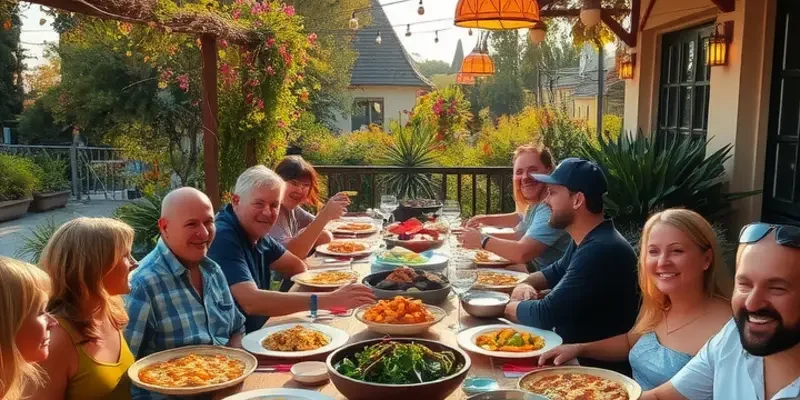Dining together is an ancient ritual, steeped in traditions that varying cultures hold dear. Through shared meals, we explore identities, celebrate community, and create lasting bonds. This journey into the world of dining highlights how food shapes relationships, reflects cultural values, and invites exploration of diverse cuisines. From communal feasts to intimate family dinners, the way we approach food brings meaning to our lives and offers a glimpse into different ways of being and belonging.
Communal Feasts: Celebrating Togetherness

Across the globe, communal dining traditions create invaluable opportunities for connection. In the sunlight-drenched Mediterranean, mezze platters bring people together around colorful assortments of dips, bread, and small bites. These dishes encourage sharing, conversation, and a lingering at the table that reinforces social bonds. Similarly, in Ethiopia, the communal meal centers around injera—a spongy flatbread that serves as both plate and utensil. Diners share a large, circular tray topped with diverse stews and salads, each person tearing off pieces of injera to scoop up the vibrant flavors. This collective approach to eating not only satiates hunger but cultivates a sentiment of unity.
For many cultures, the act of preparing and partaking in food together is deeply symbolic. It acknowledges not just the sharing of space but also life’s moments, significant and small. In Japan, the communal dining experience of sharing sushi or sukiyaki stresses harmony and collective enjoyment—key principles in Japanese society. Each participant contributes to and partakes in the whole, blurring the line between individual and group. In such environments, food becomes the narrative, weaving stories and traditions through everyday interactions.
Toasts are another integral facet of communal meals, serving as a verbal acknowledgment of togetherness. In Eastern European countries, toasting is not just a gesture but an art form. Each toast is a thoughtful tribute—whether to health, happiness, or friendship—projecting gratitude and fostering a sense of belonging. In Greece, shouting “Yamas!” enhances the collective dining atmosphere by verbally affirming shared kinship.
Rituals often accompany communal dining traditions, anchoring us to our roots and highlighting seasonal or cultural landmarks. In India, festivals like Diwali are marked by lavish feasts, where preparation is as much about social assembling as it is about the meal itself. Families and friends come together, cooking and sharing multi-course meals rich in spices, transforming dining into a celebration of prosperity and peace.
The scalability of communal feasts makes them versatile. They can be as humble as a neighborhood potluck or as grand as a wedding banquet. In China, communal dining tables are a staple at celebrations—be it a wedding or the new year—with rotating lazy Susans laden with a variety of dishes everyone is encouraged to sample. This style of dining underlines the Chinese cultural emphasis on harmony and shared happiness.
Within these diverse traditions, one can appreciate the localized expression of global concepts. Communal dining not only reflects cultural norms but also adapts sustainably to solve practical challenges—such as reducing food waste by serving family-style meals where portions can be adjusted based on communal needs. For insights on integrating communal meal practices into everyday life, consider enhancing your culinary routines with resourceful strategies for practical ingredient batching. Sharing meals consistently strengthens our connections to each other, reminding us that dining together can be the cornerstone of cultural appreciation and human connection.
Traditions of Ritual: Families and Festivals

Family meals and festive gatherings are more than just servings of food; they are immersive cultural experiences. In Japan, the New Year celebration, known as Oshogatsu, embodies wishes for prosperity and renewal. Osechi-ryori, the traditional food served during this time, features an array of elaborately curated dishes. Each item holds symbolic significance. For example, black soybeans, or kuromame, are eaten for health, while fish roe, kazunoko, signifies the hope for many children.
The preparation and consumption of osechi-ryori is a meticulous ritual. Families gather, sometimes spending days cooking and arranging these dishes into jubako—tiered lacquered boxes. This process strengthens familial bonds and offers time to reminisce about the past year, reinforcing communal ties and cultural heritage through shared meals.
In contrast, the American Thanksgiving is steeped in gratitude and remembrance. This holiday traces its roots to the 17th century and has evolved to represent a collective time for families to come together. The iconic turkey centerpiece, accompanied by rich gravies, tart cranberries, and hearty stuffing, symbolizes the harvest’s abundance. Each dish tells a part of America’s immigrant story, integrating diverse culinary influences into a uniquely North American tradition.
The ritualistic preparation of food for Thanksgiving invites family members to play distinct roles. From the eldest meticulously preparing the turkey, to the younger ones learning to bake pies, these shared activities foster intergenerational connections. Conversations spark over tasks, recollecting family lore and creating new memories, both essential ingredients in the recipe of cultural identity.
Every dish served at these gatherings is a narrative, a way for families to express values and preserve history. Beyond the flavor and aroma, meals during these occasions weave a complex tapestry that showcases distinct cultural narratives. Such traditions underscore the structure of these societies, emphasizing themes like renewal, gratitude, and unity.
As meals are crafted and shared, they act as vessels for cultural storytelling, reflecting the dynamic nature of tradition. Gathering around the table is an ancient human practice, yet its essence remains powerful—uniting individuals and celebrating shared humanity. These meals become more than consumption, morphing into ceremony.
To explore more on incorporating cultural influences into everyday meals, our guide to culinary influences and trade provides interesting insights. Understanding these influences can enrich our appreciation of how food traditions influence family and societal culture.
In conclusion, the rituals of family meals and festive gatherings show us the world through tastes, smells, and conversations. They convey values, tell stories, and form a bridge across generations. Whether it’s osechi-ryori in Japan or Thanksgiving in America, these traditions reinforce our sense of belonging and identity through the simple act of sharing food.
Final words
Dining together serves as a universal language, embodying cultural narratives and emotional bonds that transcend borders. As we’ve explored, meals are more than the food on our plates; they encapsulate our histories, traditions, and shared enjoyments. Each culinary practice invites us to connect with others, creating a tapestry of experiences that enrich our understanding of diverse cultures. Embracing these global dining practices not only satisfies our palates but also nourishes our spirit, reminding us of the communal dimensions of food.








